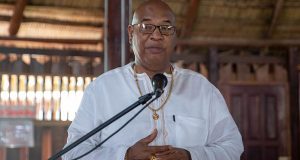SANTIAGO, Chile, December 15, 2019 (CMC) – Economic activity in Guyana continues to accelerate, ahead of the oil boom expected in 2020, with growth projected at 4.5 percent in 2019, up from 4.1 percent the previous year, according to the Economic Commissioner for Latin America and the Caribbean (ECLAC).
ECLAC said that the overall fiscal deficit is projected to deteriorate from 3.6 percent of gross domestic product (GDP) in 2018, to 4.9 percent of GDP in 2019, as an increase in expenditure of 16 percent outweighs improved revenue.
“The overall balance-of-payments deficit is likely to contract in 2019, on account of an increase in foreign direct investment (FDI) in the energy sector, despite a higher current account deficit. Inflation is expected to rise moderately, to 2.5 percent in December 2019, from 1.6 percent a year earlier, on the back of higher food prices.
“In 2020, the economy is expected to expand, substantially, by 85.6 percent as commercial oil production will commence in December 2019. Even the non-oil growth rate is expected to reach 4.8 percent, owing to a spillover effect of oil production on other sectors,” ECLAC said in its latest “Preliminary Overview of the Economies of Latin America and the Caribbean 2019”, released, here.
ECLAC said the government is committed to institution-building to improve revenue collection and create new industries and jobs, and that the revised 2019 budget shows total revenue, including grant receipts, rising by 11.3 percent following a 9.9 percent increase in 2018, thanks to improved tax collection, mainly from the oil and gas sector.
It said total expenditure is expected to jump by 16 percent in 2019, a significant rise on the 6.1 percent increase seen in 2018, reflecting the government’s initiative to increase workers’ income and promote infrastructure developments.
It said part of the oil revenue will be saved under the Natural Resource Fund (NRF) Act 2019, which was signed into law in January, in an effort to build capacities to manage and monitor oil revenues. The Act also established a Public Accountability and Oversight Committee to assess management of the Fund and a fiscal transfer rule to govern the flow of resources from the Fund to the government budget.
ECLAC said that the monetary policy stance remained accommodative, as redemptions of Treasury bills, issued for monetary policy purposes, amounted to GUY$24.1 billion during the first half of 2019, exceeding issuances of GUY$8.2 billion, while the central bank rate was unchanged at five percent, during the first 11 months of 2019.
Under the accommodative monetary stance, Treasury bill rates and commercial bank lending rates fell slightly during the first nine months of 2019. The falling interest rates underpinned the increase in net domestic credit, up 19 percent year-on-year in September 2019.
Private sector credit increased by 6.7 percent, supported by an expansion in loans and advances to individuals and businesses. Public sector credit expanded, significantly, by GUY$28 billion, mainly as a result of a worsening central government net credit position. Owing to the uptick in domestic credit, along with a 16.9 percent increase in net foreign assets, the broad measure of money supply increased by 14.5 percent, ECLAC added.
ECLAC said that Guyana’s overall balance-of-payments deficit is likely to narrow, slightly, by US$26.1million, to US$106.1 million in 2019, owing to a higher surplus on the capital account, despite a higher current account deficit.
It said the current account deficit is expected to increase by US$53 million to US$1.379 billion, despite a recovery in gold exports, owing to stronger imports, as a result of large investments in the oil and gas sector and higher payments for transportation services.
Meanwhile, the capital and financial account surplus is expected to widen by US$87 million to US$1.273 billion, with higher net inflows of FDI in the energy sector.
“The Guyanese economy continued to post robust growth, ahead of the oil boom expected in 2020, with growth estimated at 4.0 percent during the first half of 2019. The construction sector made the largest contribution to growth, reflecting an increase in both private investment and government expenditure on construction activities,” ECLAC said.
It said the mining and quarrying sector continued to recover, as gold mining expanded, in response to improved road conditions and favourable international prices.
“On the other hand, the agriculture, fishing and forestry sector contracted slightly, as a large livestock producer reduced output of broiler meat to run down stocks. As the growth momentum is likely to continue into the second half of 2019, the growth rate is expected to accelerate to 4.5 percent for the year overall, from 4.1 percent in 2018.”
 Pride News Canada's Leader In African Canadian & Caribbean News, Views & Lifestyle
Pride News Canada's Leader In African Canadian & Caribbean News, Views & Lifestyle




